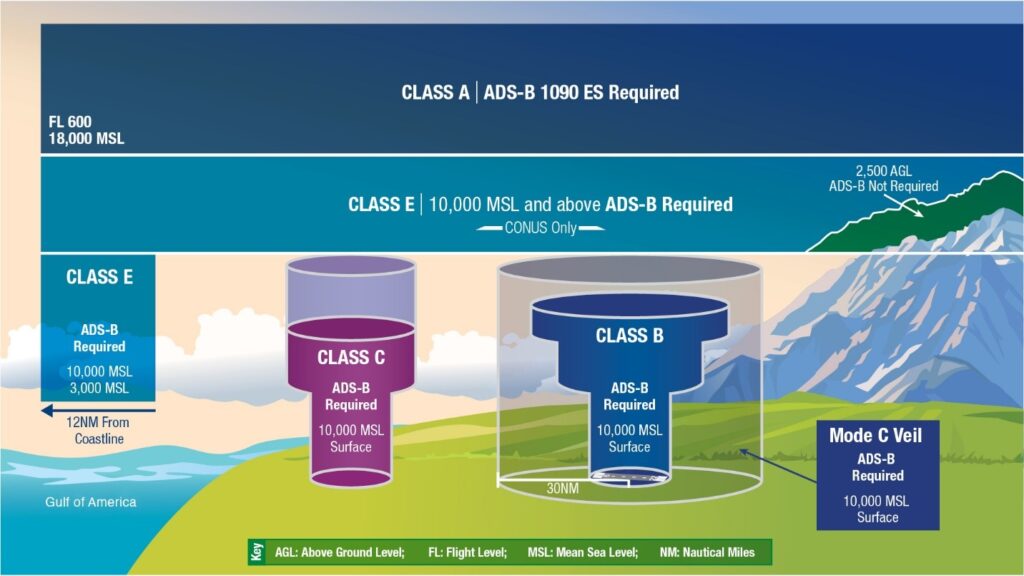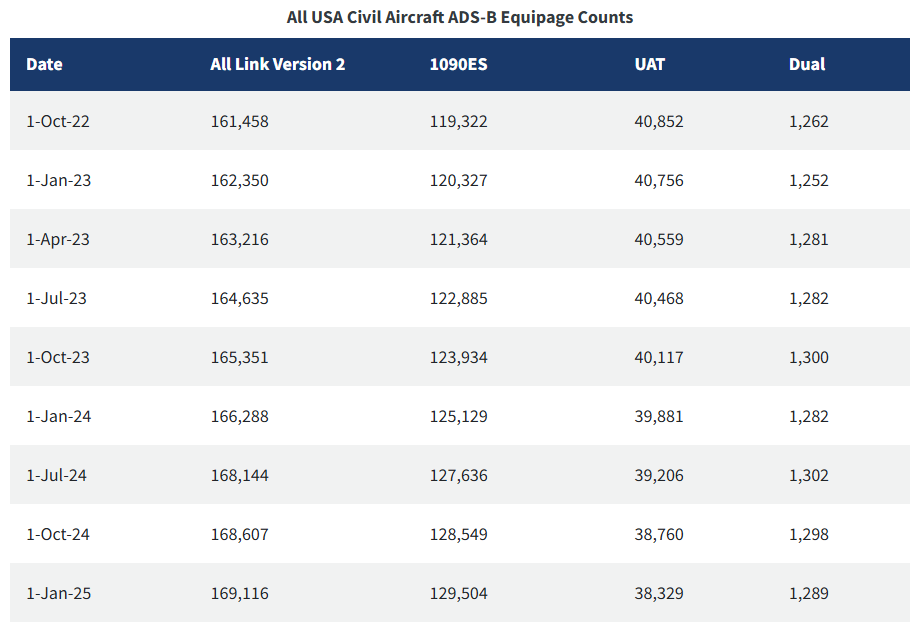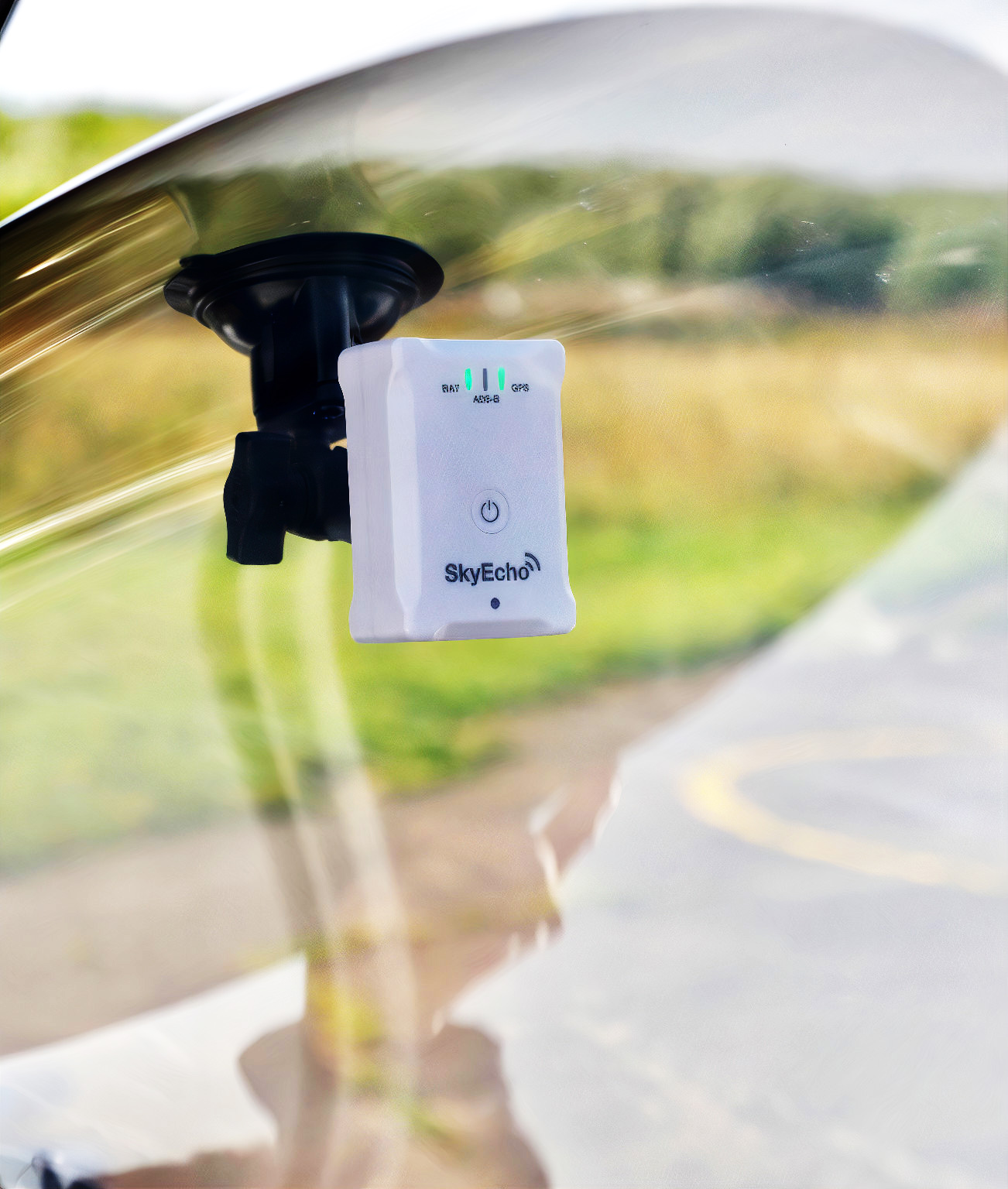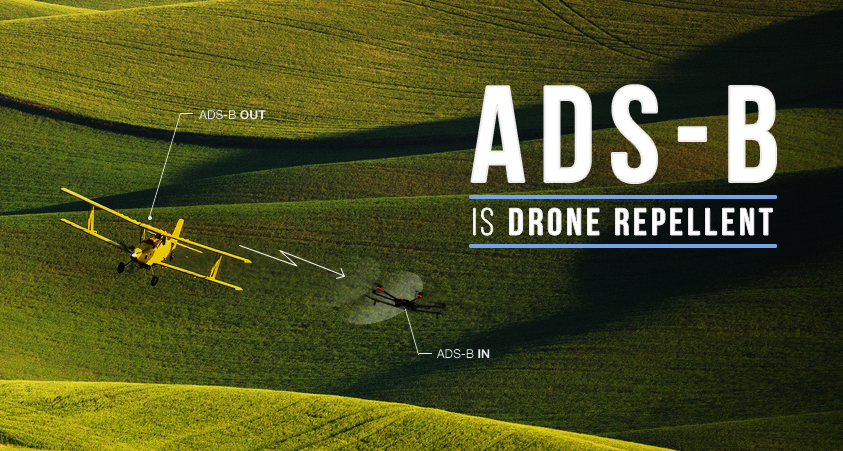Harnessing the Shifting Landscape of ADS-B Equipage: Opportunities for Electronic Conspicuity and UAS

Since the FAA’s ADS-B Out mandate became effective in January 2020, aviation equipage has continued to evolve. The regulation, designed to enhance situational awareness, safety, and air traffic efficiency, mandates that aircraft install transmitting equipment (“ADS-B Out”) within specific airspace classes (Class A, B, and C) and above 10,000 feet Mean Sea Level (MSL). Despite the mandate, FAA data reveals that many aircraft remain unequipped and at risk.
Understanding ADS-B Airspace Requirements
The FAA provides a detailed map of ADS-B Out requirements across the U.S. airspace, which largely aligns with traditional Mode C veil areas, en route controlled airspace, and the upper flight levels. These airspaces are detailed in 14 CFR 91.225. While the rule was designed to modernize air traffic surveillance and improve safety, the implementation of ADS-B Out has led to an ongoing transition in technology choices among operators.

The FAA publishes a quarterly update on ADS-B equipage statistics, and five years on from the mandate, most assume that ADS-B equipage is ubiquitous. However, based on the FAA’s equipage data, there are somewhere between 20,000-30,000 general aviation (GA) aircraft and helicopters that fly at lower altitudes in uncontrolled airspace that are not equipped. These are the exact aircraft that are at highest risk for collision with UAS.
The image below (downloadable from the FAA here) illustrates the airspace below 10,000 feet MSL where ADS-B is required. As shown, there is a significant amount of geographic airspace where a lack of electronic conspicuity for all airspace users can pose significant risk to low altitude operations. ADS-B is ONLY required within the circles indicated on the map below 10,000 feet MSL.

The Decline of UAT and the Rise of 1090ES
ADS-B Out can be transmitted on two frequencies: 1090 MHz Extended Squitter (ES), primarily used by commercial and high-altitude aircraft, and 978 MHz Universal Access Transceivers (UAT), which was intended for general aviation aircraft flying below 18,000 feet. 978 MHz UAT was introduced to alleviate over-use of the 1090 MHz ES spectrum, which is the core frequency used by all transponders and Traffic Collision Avoidance Systems (TCAS). The dual-frequency system was designed to accommodate a broad range of operators, but data from the FAA’s equipage tracking suggests that the industry is increasingly favoring 1090 MHz ES.
A recent analysis of equipage trends reveals a shift in how aircraft are complying with the mandate, particularly in the adoption of 1090 MHz ES transponders over UAT operating at 978 MHz. UAT usage peaked at ~ 40,912 aircraft in July 2022. The April 2025 figure sits at 38,070 – a decline of 2,832 aircraft over 3 years. This shift creates new opportunities for uncrewed aircraft systems (UAS) and smaller GA aircraft.

The transition appears to be driven by several factors:
- International Compatibility – Unlike UAT, which is limited to the U.S., 1090 MHz ES is the global standard, making it a more practical choice for aircraft operating internationally.
- Avionics Modernization and Transponder Attrition – Most UAT installations were “add-on” systems that worked with the existing, aging, Mode C transponders. This was almost always done because it was the lowest cost path to compliance. However, over time, those aging Mode C transponders fail, and as transponders are replaced, they are typically replaced with an all-in-one 1090 MHz ES ADS-B transponder.
This shift has important implications for spectrum utilization. As more aircraft transition to 1090 MHz ES, UAT frequencies experience reduced traffic. Since UAT was originally designed to serve the GA community and avoid congestion on 1090 MHz, its decreasing use now presents a new opportunity.
A New Opportunity for UAS and Unequipped GA Aircraft
With fewer GA aircraft using UAT, the 978 MHz spectrum remains underutilized, opening the door for the integration of new airspace users, particularly UAS and GA aircraft that are currently unequipped with ADS-B Out.
For GA, there is the possibility for portable UAT ADS-B Out devices called Electronic Conspicuity (EC) devices. EC devices cost hundreds or thousands of dollars less than an installed ADS-B Out system and can provide anonymous ADS-B out signals, reducing the risk of mid-air collisions while addressing the two largest objections to ADS-B which are 1. Cost and 2. Privacy concerns. See our recent post on some FAA testing of portable EC technology.
For UAS operators, UAT 978 MHz spectrum presents an opportunity to introduce low-power ADS-B Out solutions that support Beyond Visual Line of Sight (BVLOS) UAS operations. These low Size Weight and Power (low SWaP) systems can be spectrally efficient or designed with “inert and alert” capability so as to not transmit at all unless they detect an encroaching aircraft. To-date, the FAA has prohibited the use of UAT 978 MHz ADS-B on UAS for spectrum congestion concerns. With the declining use of this spectrum and the shift to 1090 MHz ES, we are now seeing a situation where an already underutilized spectrum is opening up even further. The UK CAA just recently took this exact action authorizing and allocating the 978 MHz spectrum for ADS-B on UAS for surveillance and identification.
Looking Ahead
The FAA’s ADS-B Out mandate was just the beginning of a larger transformation in aviation surveillance. As equipage trends shift toward 1090 MHz ES, the airspace environment is evolving in ways that may benefit previously underserved operators. The declining use of the 978 MHz UAT spectrum opens the door for increased adoption by UAS and smaller GA aircraft, creating new opportunities for safer and more efficient airspace integration.
Understanding these trends is crucial for aircraft operators, avionics manufacturers, and policymakers as they shape the future of airspace management. Whether it’s ADS-B Out compliance, UAS integration, or the next phase of air traffic surveillance, one thing is clear: the skies are continuing to evolve.


